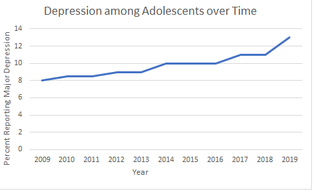Health
Flatten the Mental Health Curve
How we are heading toward a mental health pandemic and what to do about it.
Posted July 8, 2021 Reviewed by Lybi Ma
Key points
- Mental health issues are steeply on the rise among adolescents and young adults.
- This rise in mental health issues is exacerbated in industrialized parts of the world.
- Three potential causes of this trend, along with three potential solutions, are offered here.

Picture this: Tenth-grade Laura checks her Instagram after a long school day. And she finds something that is absolutely horrific. Her long-time adversary, Gertrude, has posted a nude photo on her Instagram story. The photo is a bit blurry, but it kind of looks like Laura. And, although it's actually not Laura in the photo, Gertrude claims that it is and she even tags Laura with some very nasty verbiage. The post goes viral.
Laura's anxiety level shot through the roof as she stood there alone on her driveway. She had never experienced this level of hurt before and she had no clue whatsoever as to what she was going to do about it. Feelings of hopelessness, anxiety, and depression engulf her.
The Skyrocketing Nature of Mental Health Issues in Modern Times
In a large-scale study of the prevalence of various mental health issues, including anxiety, depression, and mood disorders, it was found that steep increases in each and every such condition were found for adolescents and young adults between the years of 2009 and 2017 (see Twenge et al., 2019). We are talking about increases in major depression, for instance, from 8 percent to more than 13 percent among those in the 12- to 25-year age range across these nine years. This same general trend seems to exist for mental health issues in general. Anyone who works on a college campus will tell you that counseling centers are running beyond capacity across the US.
Mental health issues are on the rise. And this trend is particularly true among our young people (Twenge et al., 2019).

A year ago, when people talked about flattening the curve, they were referring to the COVID pandemic. I think it is time to revise our usage of this phrase. As we work as a global community to put the COVID pandemic behind us, I say that the phrase flattening the curve be rebranded to refer to the steep increase in the prevalence of mental health issues in the modern world—especially among young people.
Three Potential Causes of the Problem
Twenge et al. (2019) offer a few suggestions to explain the trends found in their data. Generally, they refer to "birth cohort effects," suggesting that people born after 1982 have access to digital media and other online resources that have had unintended adverse consequences regarding the mental health of adolescents and young adults today. While this explanation is speculative in nature given the non-experimental quality of the data in their study, I think it's certainly a perspective that warrants further study. With this said, here are three specific potential causes that I think warrant our deepest consideration.
1. Cyberbullying.
In line with the analysis presented by Twenge et al. (2019), we can consider cyberbullying as a specific trend that has risen hand-in-hand with rises in communication technologies such as the internet and social media.
According to data compiled by Comparitech, rates of cyberbullying have increased sharply across the globe over the past decade. Below is a slice of the eye-opening data found in their report:
Between 2011 and 2018, rates of cyberbullying among teens have increased markedly in nearly every nation across the globe. For instance, in the US, rates of teens reporting having been victims of cyberbullying increased from 15 percent in 2011 to 26 percent in 2018. These comparable rates for a few other nations, just to put a global face to the problem, are as follows:
Turkey: 2011, 5 percent; 2018, 20 percent
Mexico: 2011, 8 percent; 2018, 18 percent
UK: 2011, 11 percent; 2018, 18 percent
China: 2011, 11 percent; 2018, 17 percent
2. Increases in industrialization have ironic effects when it comes to mental health.
Generally, we think of technological advancement as a good thing. But I would argue from an evolutionary perspective that any and all technological advancements need to be considered with caution.
When it comes to large-scale industrialization, people who live in relatively large, industrialized areas are more at-risk for mental health issues than are people who live in relatively small-scale social environments. And this finding seems to be true across the globe (see Srivastava, 2009). As time moves forward, technology and industrialization increase. And adverse mental health outcomes of our young people seem like a fully adverse (if unintended) consequence of this pattern.
3. Increased evolutionary mismatch in general.
Generally speaking, evolutionary mismatch, or the tendency for an organism to exist in environmental conditions that are mismatched from the ancestral conditions that surrounded the evolutionary history of that organism, tends to have adverse consequences for organisms.
And as technology advances, our world becomes more and more mismatched from the small-scale societies that our ancestors evolved in. Modern communication systems are, in many ways, among the most mismatched features of the modern world (see Geher, 2020; Geher & Wedberg, 2020). Under modern conditions, people have lost the tendency to communicate primarily through good old-fashioned face-to-face interactions. Instead, we so often communicate through screens, often with people whom we've never actually met. Opportunities for anonymity and deception in human communication are at all-time highs and are only going to increase from here. And all the social psychological research that exists on the effects of anonymity on social behavior suggests a major bottom line: When people's identities are hidden, they are more likely to act in nasty and anti-social ways (see Zimbardo, 2007). That's the world that surrounds the young people of today.
Three potential solutions
People often tell me that I'm super-optimistic; perhaps even overly optimistic. Well, I'm sorry if this particular post is less rose-colored than is most of my work. This said, I'm a big fan of proposing solutions whenever talking about problems. With that said, here are three potential solutions to this mental health epidemic that I hope might be useful for anyone who is interested in building a brighter future to consider.
1. Genuinely limit screen time.
Humans did not evolve to be able to communicate with anyone at any time using a variety of anonymous and potentially deceptive communication methods. That cellphone in your hand right now is more dangerous than you might possibly imagine. Limiting screen time on a large scale will, no doubt, lead to positive social and emotional outcomes for all of us.
2. Get into nature.
As young people spend more time playing Fortnight and Minecraft, they are spending less and less time outdoors. Our ancestors evolved to be surrounded by nature and, in fact, humans can be said to have a natural love of the outdoors (see Wilson, 1984). Outdoor experiences generally help clear one's mind and facilitate all kinds of positive affective reactions. The world is a beautiful place. Let's get our kids out there to truly experience it in all its wonder.
3. Emphasize this content in curricula in the schools.
Schools have worked to integrate mental health concerns into their curriculum (e.g., in health class) and administration (e.g., via school psychologists and counselors). This trend is a welcome one given the nature of the rising rates of mental health issues among the young.
This said, secondary school curricula do not tend to include concepts related to evolution outside of the biology classroom. Based on the ideas presented here, perhaps it would be useful for some part of high school curricula to focus on who we are from an evolutionary perspective. Humans evolved in small-scale societies including kin and others with whom they have long-standing relationships. Humans evolved to be surrounded by nature. Humans, with roots in nomadism, evolved to exercise extensively and regularly and to eat only natural foods. Humans evolved to form cooperative and trusting relationships with others that could last up to a lifetime. And we evolved under conditions in which the only possible form of communication was of the face-to-face variety.
Bottom Line
While we don't fully know all the reasons, there is a nearly all-out mental health pandemic brewing in the modern world. And this problem is disproportionately affecting adolescents and young adults. Understanding the causes of this troubling trend and addressing it at its core needs to be an absolute priority for all of us. Applying an evolutionary perspective, that steps back and examines how modern technologies are mismatched from the ancestral conditions that surrounded our evolution, is, to my mind, essential in helping us to truly get a grip on this issue.
We need to flatten the mental health curve. And we need to do it together.
*Thanks to Psychology Today reader Olina Raney for providing the encouragement and inspiration for this post.
References
See my book (with Nicole Wedberg) Positive Evolutionary Psychology: Darwin's Guide to Living a Richer Life for a detailed and scholarly summary of this take on the human experience
Srivastava, K. (2009). Urbanization and mental health, Industrial Psychiatry Journal, 18, 75-76.
Twenge, J. M., Cooper, A. B., Joiner, T. E., Duffy, M. E., & Binau, S. G. (2019). Age, period, and cohort trends in mood disorder indicators and suicide-related outcomes in a nationally representative dataset, 2005-2017. Journal of Abnormal Psychology, 128, 185-199.
Wilson, Edward O. (1984). Biophilia. Cambridge: Harvard University Press.
Zimbardo, P. (2007). The Lucifer Effect: Understanding How Good People Turn Evil". The Journal of The American Medical Association. 298 (11): 1338–1340.




